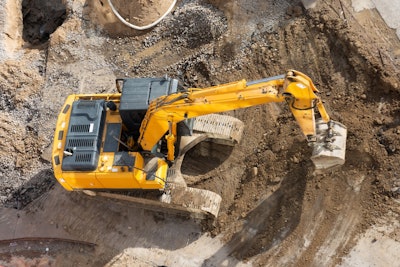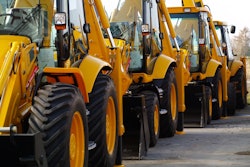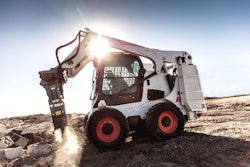
 As the Central and East Region Manager for Wells Fargo's Commercial Banking Heavy Equipment Dealer Group, Chris Deininger provides strategic guidance to dealers within the agriculture, construction, heavy trucking, trailer, material handling industries, as well as truck transportation companies across Wells Fargo's central and eastern U.S. footprint.Wells Fargo
As the Central and East Region Manager for Wells Fargo's Commercial Banking Heavy Equipment Dealer Group, Chris Deininger provides strategic guidance to dealers within the agriculture, construction, heavy trucking, trailer, material handling industries, as well as truck transportation companies across Wells Fargo's central and eastern U.S. footprint.Wells Fargo
“They've got work, but they're being a little bit more cautious with the spend that they have and trying to utilize the fleet the best they can with the jobs in front of them,” Chris Deininger, Central and East region manager for Wells Fargo's Commercial Banking Heavy Equipment Dealer Group, told Equipment World.
Just as historically low interest rates during the pandemic pushed contractors toward new equipment purchases, the higher interest rates following it, combined with the increased price of new equipment due to inflationary pressures, are causing contractors to look again at rental as a way to manage costs. If contractors become less confident in the backlog of jobs, they will likely shift away from buying in favor of renting.
“A lot of dealer clients that had historically been purchasing a new unit every other year are now renting or holding onto units a little bit longer during the last 24 months. Contractors are wanting to hold on to that cash,” Deininger says. “And for some that haven't ventured into a rental, this may be an opportunity for them to try a non-traditional way of making these acquisitions - whether it's an RPO or rental - if they're uncertain about backlogs."
This new normal has forced dealers to pivot as equipment availability has increased at the same time demand has been sated. Deininger predicts that higher inventory levels could motivate some dealers to cut prices or offer purchase incentives to move units off their lots and maintain market share. “I wouldn’t be surprised if some dealers don’t have a price increase this year, or in fact, may offer some pretty attractive rates just to help move inventory,” he says.
[Related Content: Renting vs. Buying: EquipmentWatch Report Sheds Light on Contractors’ Habits]
On the flip side, the slowdown of new equipment purchases is driving parts and service revenues, with Deininger noting some dealers have seen “up to a 40% pick up in that business.”
Used equipment sales and auction sales have also inched up as prices moderate from record highs and contractors look for better deals in the short term. “If they’re buying from an auction, it’s 50% lower than where it was 18 months ago. If buying from a dealer or retail, it's 20% off from the highs," he says.
 Wells Fargo says values in both the general construction and heavy earthmoving sectors have recently moderated over the last 18 months given tougher prior period comparisons and improving supply chains for new equipment.Wells Fargo/Rouse Services “The Equipment Report” Report”, February 2024
Wells Fargo says values in both the general construction and heavy earthmoving sectors have recently moderated over the last 18 months given tougher prior period comparisons and improving supply chains for new equipment.Wells Fargo/Rouse Services “The Equipment Report” Report”, February 2024
But it’s not all bad news for new equipment sales. He notes that project activity drives equipment demand and infrastructure, and mega project spending will boost heavy equipment sales for years to come.
“Dealers more focused on the residential and landscape equipment sector have experienced a bit more shock because of the housing slowdown due to higher interest rates,” Deininger says. “Dealers focused on road building and bridge building equipment are feeling a bit more optimistic as there is more wind in their sales from a spending standpoint.”
Despite the economic uncertainties, especially during an election year, Wells Fargo remains bullish on the construction sector as a whole. The Dodge Momentum Index backs up that sentiment. The monthly report, which is shown to lead construction spending by 12-18 months, remains elevated and supports a positive outlook for construction activity.
“If you look at the spend for the infrastructure bill, spending through 2030 will be above historical norms,” Deininger says. “With that in mind, there’s only been about 8 to 12 percent of that $550 billion dedicated to infrastructure that’s been spent so far. There’s a lot more money to be pumped through the system for contractors and dealers to benefit from.”
 The chart above illustrates how the Infrastructure Investment and Jobs Act funding is projected to be spent through 2033.Wells Fargo Economics, The Congressional Budget Office
The chart above illustrates how the Infrastructure Investment and Jobs Act funding is projected to be spent through 2033.Wells Fargo Economics, The Congressional Budget Office
Looking ahead, Deininger recommends dealers take a measured approach to ensure they are getting the right financial and physical utilization of rental fleets. Many dealers are sitting on aged rental fleets that are currently achieving a high return on investment thanks to the strong demand. However, as dealers refresh their fleets, there will need to be significant appreciation in rental rates to support the higher acquisition cost of new equipment being added.













